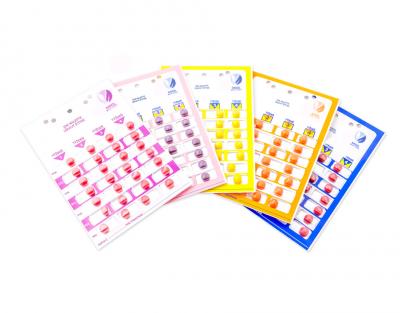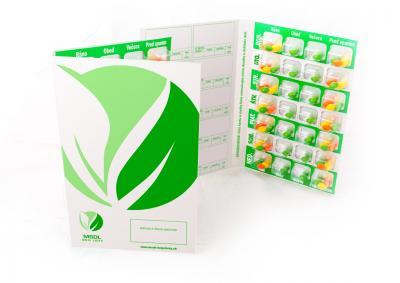Summary: Nursing and residential homes facility should maintain a current, accurate and reliable record of the drugs prescribed and given to a resident. The correct use of a medication chart can meet this requirement. The hard-copy of Nursing and Residential homes Medication Chart aims to provide a standard form for the prescription, dispensing and administration of drugs. In addition to providing a comprehensive record, it should facilitate communications between health professionals who are unlikely to visit nursing and residential facilities at the same time. The chart will also enable pharmacists to supply most drugs without the need for a separate prescription. This should reduce transcription errors and avoid delays in the supply of medicines.
Keywords: Medication error, Nursing homes, Nursing staff, Social knowledge.

INTRODUCTION
A medication chart in a residential and nursing facility serves as a communication tool between doctors, nurses, pharmacists, other health professionals and hospitals regarding a resident’s medicines. It is used to direct how and when drugs are to be administered and as a record of their administration by qualified nurses.
There are almost 1050 nursing and residential facilities in Slovakia with approximately 235.000 residents. With an average of 9.75 medications per resident, poly-pharmacy (defined as the concurrent use of five or more drugs) is widespread. Guiding principles for medication management in nursing and residential facilities’. This states that ‘facilities should ensure all residents have a current, accurate and reliable record of all medicines selected, prescribed and used, to support safe prescribing and administration’. The correct use of an appropriately designed medication chart hard copy, addresses this requirement.
Most facilities use proprietary printed medication charts available from commercial printers, aged-care service company’s versions from agencies whose charts are able to be printed on site.
ISSUES WITH MEDICATION CHARTS IN RESIDENTIAL AGED CARE
The proprietary printed charts used in nursing and residential facilities are usually multiple-page booklets designed to last for periods of up to six months. Whereas patients, doctors, nurses and pharmacists are usually co-located in hospitals and can physically use the same chart, this is not the case in nursing and residential facilities. Their differing locations result in all paperwork needing to be copied and faxed or shared electronically between the facility, doctors and pharmacists. The multiple-page booklet format of the charts used in aged care complicates transmitting a comprehensive record of a resident’s current treatments.
Drugs can be supplied to residents of nursing and residential facilities in original packs dispensed by a pharmacist and labelled with instructions for administration or supplied in dose administration aids. These aids may be packed with a single drug per pack (unit dose) or with a number of drugs due to be simultaneously administered to the resident (multi dose). While dose administration aid has become common place in nursing and residential facilities, not all prescribed drugs can be packed together due to formulation, stability or regulatory restraints. This frequently results in the use of parallel supply systems of original packs and dose administration aids.
All jurisdictions require a registered or enrolled nurse to be responsible for the drugs given in a nursing and residential facility. However, in some circumstances, trained nursing assistants are able to help residents to self-administer medicines. If supplied in an original pack, the nurse who administers a drug is required to verify it against the doctor’s order, select the correct quantity and record the administration on the chart. If the drug is supplied in a dose administration aid, the staff member who assists a resident to self-administer or who administers the contents must sign for doing so without the responsibility of identifying each drug. Medication charts need to be able to accommodate these differences in packaging and the obligations for documentation.
Any scheduled drug ordered on a medication chart in a nursing and residential facility requires a separate prescription to be written to facilitate supply and, if the medicine is listed on the Pharmaceutical Benefits Scheme, to enable reimbursement of the pharmacist. There are risks associated with the duplication of a written medication order. There are also additional ‘clerical’ obligations and a potential for a delay in treatment. Any tardiness in writing a complete prescription may entail a delay in supply or payment and, if the prescription is never written, there will be no reimbursement of the cost.
ELECTRONIC ADVANCES E-HEALTH
Studies have shown that the implementation of electronic medication management systems which link nursing and residential facilities with prescribers and pharmacists improves clarity and accuracy, provides efficiency and enhances safety. The systems were developed as tools to record and report on drug administration, but now include sharing of real-time data on adherence and changes to treatment, and the ordering of stock. The electronic version of the doctor’s order displays just the current drugs resulting in a much simpler document than the proprietary printed charts. Administration sign-off can be paper-based or completed electronically.

THE NATIONAL RESIDENTIAL MEDICATION CHART
This initiative was intended to reduce the administrative burden for prescribers, pharmacists and nurse staff by improving the timeliness of prescribing and dispensing and minimising the duplication of effort for the president’s healthcare team. The concept should enhance medication safety by reducing the risk of transcription errors that arise from the need to write drug orders twice – once on the chart and again on the prescription.
The development of the Nursing and Residential Medication Chart addressed the sections, layout, functionality and duration of the chart. Evaluation in 52 nursing and residential facilities demonstrated significant reductions in medication administration errors and less incorrect packaging of residents’ medicines. The National Residential Medication Chart is at this stage paper-based, however there is potential for software providers to develop an electronic option.
FORMAT
The Nursing and Residential Medication Chart is a 52-page landscape format booklet that includes sections for patient identification, resident assessment, allergy, and weight and blood glucose documentation. It is intended to last for four months. Space is provided for ordering and recording the administration of regular drugs, eight short-term drugs, six ‘when-required’ drugs, three nurse-initiated medicines. There can be three warfarin orders (or other variable dose drugs) with related pathology instructions and results, three regular insulin orders and four ‘when-required’ insulin orders. The chart also includes space for recording nutritional supplementation and supply to residents from dose administration aids.
IMPLEMENTATION
The Nursing and Residential Medication Chart incorporates some of the medicine safety principles of the Inpatient Medication Chart. However, the desired safety and efficiency outcomes will only be achieved if nursing and residential facilities and health professionals find the Chart easy to use. General practitioner, and companies printing drug therapy charts, report that there has been limited implementation of the Medication Chart. This may be due to factors identified by nursing and residential staff, including:
- increased medication round times as a result of having to move back and forward through the many pages and different sections of the chart
- increased potential to miss drugs or a change of dose if they are written in different sections
- the cost of printing a chart incorporating many colours
- the time to communicate changes to the pharmacy as a result of needing to copy and fax a minimum of 12 pages
- the need for doctors to hand-write all entries, including sections required that would otherwise be generated automatically in their prescription software E-Health
- the need for doctors to rewrite the whole chart every four months
- the need for pharmacists to maintain a copy of at least 22 pages of the chart, access the correct page in order to record ongoing dispensing of an item, annotate the copy with details of each item dispensed, cease dispensing when the chart is four months old, and continue to access hard-copy scripts for specific drugs.
Some of the identified factors are not specific to the Medication Chart and relate to changes in practice associated with the new format and processes. Due to the range of health professionals and the significant changes involved, implementation of the Medication Chart requires a detailed change management process.
CONCLUSION
Some of the inefficiencies and risks associated with the ordering and supply of drugs in nursing and residential care facilities, arising from the external location of doctors and pharmacists, are resolved by the capacity to work from a single data source in the form of the Medication Chart. Problems associated with implementation of the chart may be due to both the format of the chart and the change in practices associated with its use. An electronic version of the Medication Chart may address the operational problems that have been noted with the introduction of the paper version.
Author: PhDr. Bc. Marcel Tóth
Discipline of Social work, ST. Elizabeth University of Health and Social sciences, University of Bratislava, Slovak Republic
REFERENCES
1. United Kingdom Government Department of Health. Ageing and aged care. Total number of operational aged care facilities and services by service type by state and territory \u2013 30 June 2016. [cited 2017 Jan 9] https://agedcare.health.gov.au/news-and-resources/publications/research-...
2. Somers M, Rose E, Simmonds D, Whitelaw C, Calver J, Beer C. Quality use of medicines in residential aged care. Aust Fam Physician 2010;39:413-6. https://www.ncbi.nlm.nih.gov/pubmed/20628681
3. Australian Government Department of Health. Guiding principles for medication management in residential aged care facilities \u2013 2012. [cited 2017 Jan 9] http://www.health.gov.au/internet/main/publishing.nsf/content/nmp-pdf-re...
4. Australian Nursing and Midwifery Federation. Nursing guidelines: management of medicines in aged care. Melbourne: ANMF; 2013. https://www.nps.org.au/australian-prescriber/articles/medication-charts-...
5. Burns P, Perkins D, Larsen K, Dalley A. The introduction of electronic medication charts and prescribing in aged care facilities: an evaluation. Australas J Ageing 2007;26:131-4. https://dx.doi.org/10.1111/j.1741-6612.2007.00237.x
6. Bollen C, Warren J, Whenan G. Introduction of electronic prescribing in an aged care facility. Aust Fam Physician 2005;34:283-7. https://www.ncbi.nlm.nih.gov/pubmed/15861754
7. Australian Government and the Pharmacy Guild of Australia. The fifth community pharmacy agreement between the Commonwealth of Australia and the Pharmacy Guild of Australia. [cited 2017 Jan 9] http://6cpa.com.au/about-6cpa
8. Australian Commission on Safety and Quality in Health Care. National Residential Medication Chart. [cited 2017 Jan 9] http://www.safetyandquality.gov.au/our-work/medication-safety/medication...
9. Australian Commission on Safety and Quality in Health Care. Medication charts. NIMC for adult patients. [cited 2017 Jan 9] http://www.safetyandquality.gov.au/our-work/medication-safety/medication...
10. Coombes ID, Reid C, McDougall D, Stowasser D, Duiguid M, Mitchell C. Pilot of a National Inpatient Medication Chart in Australia: improving prescribing safety and enabling prescribing training. Br J Clin Pharmacol 2011;72:338-49. https://dx.doi.org/10.1111/j.1365-2125.2011.03967.x
11. Australian Commission on Safety and Quality in Health Care. Phased implementation of the National Residential Medication Chart in NSW residential aged care facilities: evaluation report. Sydney: ACSQHC; 2014. https://www.nps.org.au/australian-prescriber/articles/medication-charts-...
12. Australian Commission on Safety and Quality in Health Care. National Residential Medication Chart v.3. Sydney: ACSQHC. [cited 2017 Jan 9] http://www.safetyandquality.gov.au/wp-content/uploads/2012/02/NRMC-v3-hi...
























